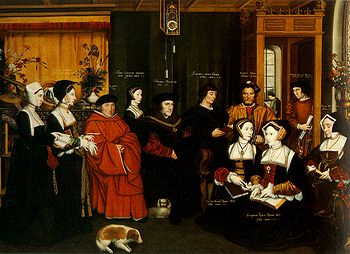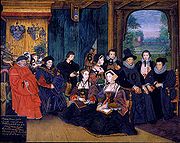
Rowland Lockey
Encyclopedia

Painting
Painting is the practice of applying paint, pigment, color or other medium to a surface . The application of the medium is commonly applied to the base with a brush but other objects can be used. In art, the term painting describes both the act and the result of the action. However, painting is...
and goldsmith
Goldsmith
A goldsmith is a metalworker who specializes in working with gold and other precious metals. Since ancient times the techniques of a goldsmith have evolved very little in order to produce items of jewelry of quality standards. In modern times actual goldsmiths are rare...
. The son of Leonard Lockey, a crossbow
Crossbow
A crossbow is a weapon consisting of a bow mounted on a stock that shoots projectiles, often called bolts or quarrels. The medieval crossbow was called by many names, most of which derived from the word ballista, a torsion engine resembling a crossbow in appearance.Historically, crossbows played a...
maker of the parish of St Bride's
St Bride's Church
St Bride's Church is a church in the City of London, England. The building's most recent incarnation was designed by Sir Christopher Wren in 1672 on Fleet Street in the City of London, though Wren's original building was largely gutted by fire during the London Blitz in 1940. Due to its location on...
, Fleet Street
Fleet Street
Fleet Street is a street in central London, United Kingdom, named after the River Fleet, a stream that now flows underground. It was the home of the British press until the 1980s...
, London, Lockey was apprenticed to Queen Elizabeth's
Elizabeth I of England
Elizabeth I was queen regnant of England and Ireland from 17 November 1558 until her death. Sometimes called The Virgin Queen, Gloriana, or Good Queen Bess, Elizabeth was the fifth and last monarch of the Tudor dynasty...
miniaturist
Portrait miniature
A portrait miniature is a miniature portrait painting, usually executed in gouache, watercolour, or enamel.Portrait miniatures began to flourish in 16th century Europe and the art was practiced during the 17th century and 18th century...
and goldsmith Nicholas Hilliard
Nicholas Hilliard
Nicholas Hilliard was an English goldsmith and limner best known for his portrait miniatures of members of the courts of Elizabeth I and James I of England. He mostly painted small oval miniatures, but also some larger cabinet miniatures, up to about ten inches tall, and at least two famous...
for eight years beginning Michaelmas
Michaelmas
Michaelmas, the feast of Saint Michael the Archangel is a day in the Western Christian calendar which occurs on 29 September...
1581 and was made a freeman or master of the Worshipful Company of Goldsmiths
Worshipful Company of Goldsmiths
The Worshipful Company of Goldsmiths is one of the Livery Companies of the City of London. The Company, which has origins in the twelfth century, received a Royal Charter in 1327. It ranks fifth in the order of precedence of Livery Companies. Its motto is Justitia Virtutum Regina, Latin for Justice...
by 1600.
He worked mainly as a copyist of earlier portraits to make up sets of oil paintings for the fashionable long galleries
Long gallery
Long gallery is an architectural term given to a long, narrow room, often with a high ceiling. In British architecture, long galleries were popular in Elizabethan and Jacobean houses. They were often located on the upper floor of the great houses of the time, and stretched across the entire...
of great houses, but signed or documented portrait miniatures on vellum
Vellum
Vellum is mammal skin prepared for writing or printing on, to produce single pages, scrolls, codices or books. It is generally smooth and durable, although there are great variations depending on preparation, the quality of the skin and the type of animal used...
and a signed title page engraving for the 1602 Bishops' Bible
Bishops' Bible
The Bishops' Bible is an English translation of the Bible which was produced under the authority of the established Church of England in 1568. It was substantially revised in 1572, and this revised edition was to be prescribed as the base text for the Authorized King James Version of...
also survive.
Versions of Holbein's More family


Hans Holbein the Younger
Hans Holbein the Younger was a German artist and printmaker who worked in a Northern Renaissance style. He is best known as one of the greatest portraitists of the 16th century. He also produced religious art, satire and Reformation propaganda, and made a significant contribution to the history...
at Nostell Priory
Nostell Priory
Nostell Priory is a Palladian house located in Nostell, near Crofton close to Wakefield, West Yorkshire, England, approached by the Doncaster road from Wakefield...
and the National Portrait Gallery in London - the original was destroyed by fire in the eighteenth century. These differ considerably, as the London version, Sir Thomas More, his father, his household and his descendants, includes More's descendants in their contemporary dress but omits several of the figures in the Holbein original. This was painted around 1593, probably commissioned by More
Thomas More
Sir Thomas More , also known by Catholics as Saint Thomas More, was an English lawyer, social philosopher, author, statesman and noted Renaissance humanist. He was an important councillor to Henry VIII of England and, for three years toward the end of his life, Lord Chancellor...
's grandson, Thomas More II, to commemorate five generations of the family. The four figures wearing ruffs and holding prayer books on the right are Thomas More II, his wife and their oldest and youngest sons. Anne More, née Cresacre (1511-77), was Sir Thomas's daughter-in-law, and appears twice: once copied from the Holbein as a young woman of about sixteen (between Sir Thomas and his father) and also as an older woman in the painting on the rear wall. A cabinet miniature
Cabinet painting
A cabinet painting is a small painting, typically no larger than about two feet in either dimension, but often much smaller. The term is especially used of paintings that show full-length figures at a small scale, as opposed to say a head painted nearly life-size, and that are painted very...
version of this portrait c. 1594 with different details, also likely by Lockey, is in the Victoria and Albert Museum
Victoria and Albert Museum
The Victoria and Albert Museum , set in the Brompton district of The Royal Borough of Kensington and Chelsea, London, England, is the world's largest museum of decorative arts and design, housing a permanent collection of over 4.5 million objects...
. There is also a surviving drawing by Holbein which confirms the general accuracy of the Nostell Priory version.
Two further copies of the Holbein, at Old Chelsea
Chelsea, London
Chelsea is an area of West London, England, bounded to the south by the River Thames, where its frontage runs from Chelsea Bridge along the Chelsea Embankment, Cheyne Walk, Lots Road and Chelsea Harbour. Its eastern boundary was once defined by the River Westbourne, which is now in a pipe above...
Town Hall and Hendred House, East Hendred
East Hendred
East Hendred is a village and civil parish in the English county of Oxfordshire, about east of Wantage in the Vale of White Horse and a similar distance west of Didcot. In 1974 it was transferred from Berkshire....
, may be by Lockey, but are too damaged and over-painted for any certainty to be possible.
Other paintings
01.jpg)
Henry VII of England
Henry VII was King of England and Lord of Ireland from his seizing the crown on 22 August 1485 until his death on 21 April 1509, as the first monarch of the House of Tudor....
, was presented to St John's College, Cambridge
St John's College, Cambridge
St John's College is a constituent college of the University of Cambridge. The college's alumni include nine Nobel Prize winners, six Prime Ministers, three archbishops, at least two princes, and three Saints....
in 1598, and a portrait of King James I of England as a young boy, now in the National Portrait Gallery, London, based on a 1574 painting by Arnold Bronckorst
Arnold Bronckorst
Arnold Bronckorst, or Bronckhorst was a painter of Netherlandish origin who was court painter to James VI of Scotland....
, is also attributed to Lockey
Lockey was long associated with the Cavendish family of Hardwick Hall
Hardwick Hall
Hardwick Hall , in Derbyshire, is one of the most significant Elizabethan country houses in England. In common with its architect Robert Smythson's other works at both Longleat House and Wollaton Hall, Hardwick Hall is one of the earliest examples of the English interpretation of the Renaissance...
, working under the patronage of Bess of Hardwick
Bess of Hardwick
Elizabeth Talbot, Countess of Shrewsbury Elizabeth Talbot, Countess of Shrewsbury Elizabeth Talbot, Countess of Shrewsbury (c. 1521 – 13 February 1608, known as Bess of Hardwick, was the daughter of John Hardwick, of Derbyshire and Elizabeth Leeke, daughter of Thomas Leeke and Margaret Fox...
between 1591 and 1597 and of her son Sir William Cavendish
William Cavendish, 1st Earl of Devonshire
William Cavendish, 1st Earl of Devonshire was an English politician and courtier.-Life:The second son of Sir William Cavendish and Bess of Hardwick, he was educated with the children of George Talbot, 6th Earl of Shrewsbury, whom his mother married after his father's death. She made him a rich...
between 1608 and 1613.
The art historian Sir Roy Strong
Roy Strong
Sir Roy Colin Strong FRSL is an English art historian, museum curator, writer, broadcaster and landscape designer. He has been director of both the National Portrait Gallery and the Victoria and Albert Museum in London...
has identified a number of inferior copies of Hilliard's portrait miniatures as probably the work of Lockey, pointing out their "weak and laboured brushstrokes" and "smudgy" features. Strong concludes that while Lockey was of "no significance as an artist" when compared to his brilliant fellow-apprentice to Hilliard Isaac Oliver
Isaac Oliver
Isaac Oliver was a French-born English portrait miniature painter.-Life and work:Born in Rouen, he moved to London in 1568 with his Huguenot parents Peter and Epiphany Oliver to escape the Wars of Religion in France...
, his importance lies in carrying Hilliard's aesthetic into the next generation.
See also
- Artists of the Tudor courtArtists of the Tudor courtThe artists of the Tudor court are the painters and limners engaged by the monarchs of England's Tudor dynasty and their courtiers between 1485 and 1603, from the reign of Henry VII to the death of Elizabeth I....
- List of British artists

